Strategic Management Analysis: Vodacom's Vision and Objectives
VerifiedAdded on 2023/04/26
|8
|2154
|313
Report
AI Summary
This report provides a comprehensive strategic analysis of Vodacom, a leading telecommunications company in South Africa. It begins with an introduction to Vodacom's market position and financial performance, followed by an evaluation of its current strategic plan, including its new positioning strategy implemented across multiple countries. The report then delves into the external and internal environmental factors impacting Vodacom, such as government regulations, economic conditions, consumer demands, and technological advancements. It outlines the company's vision, mission, and strategic objectives, including goals for revenue growth, cost efficiency, and talent development. The analysis incorporates the McKinsey 7-S model to assess the effectiveness of Vodacom's strategy, focusing on its interconnected components. The report also explores the strategic issues faced by Vodacom, such as sustainability, and identifies key stakeholders, including employees, customers, suppliers, and investors. The conclusion emphasizes the importance of strategic planning, stakeholder engagement, and environmental awareness for Vodacom's continued success. The report is a valuable resource for understanding strategic management principles within the telecommunications industry.
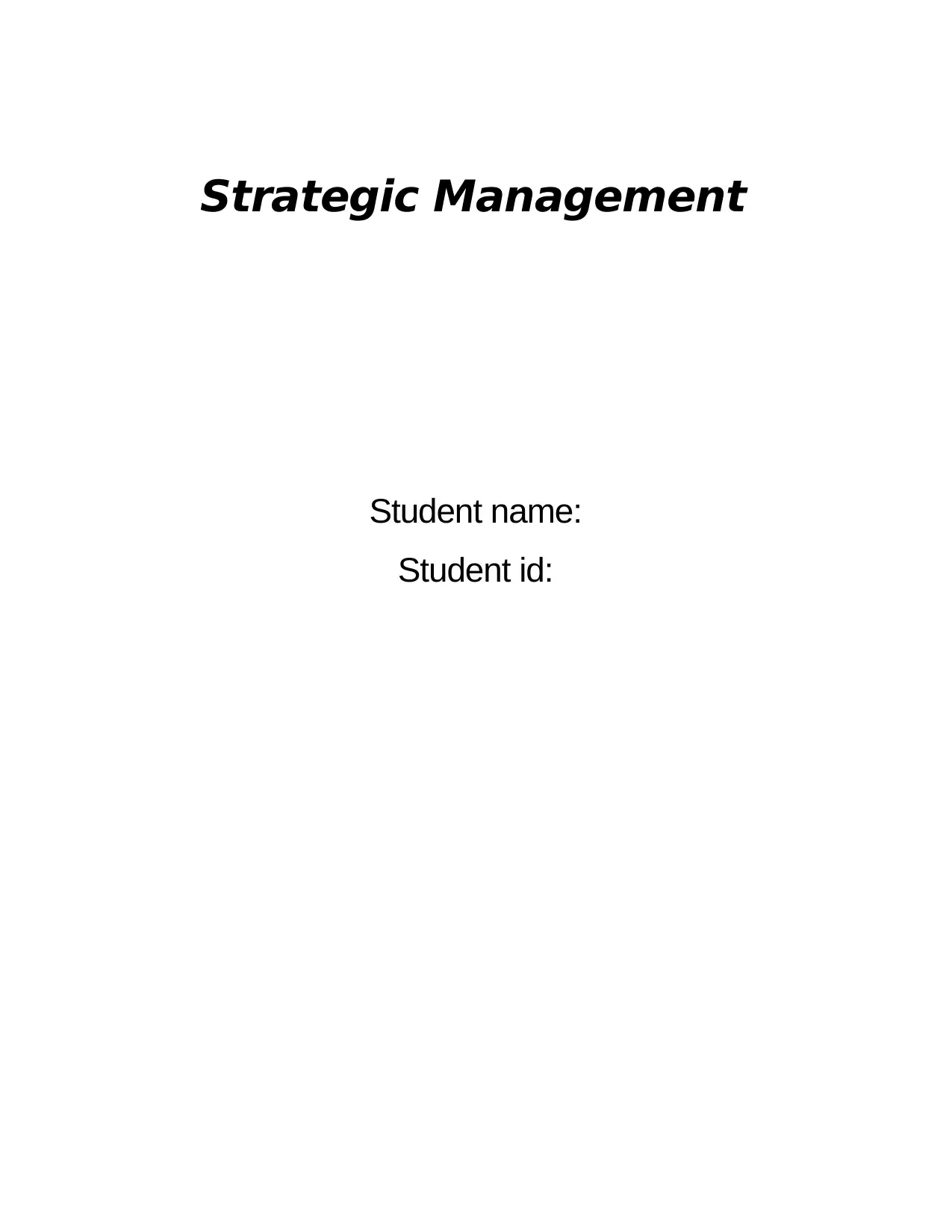
Strategic Management
Student name:
Student id:
Student name:
Student id:
Paraphrase This Document
Need a fresh take? Get an instant paraphrase of this document with our AI Paraphraser
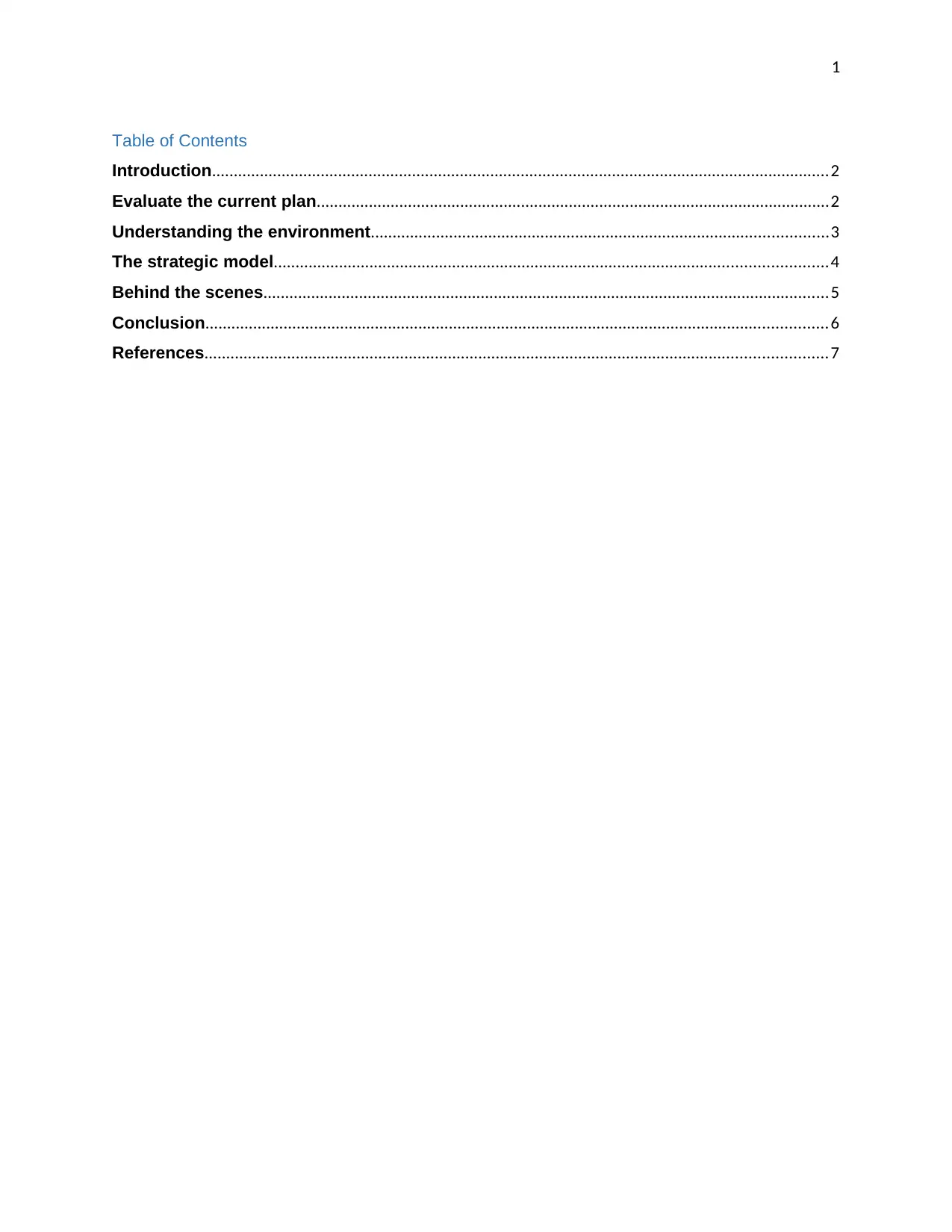
1
Table of Contents
Introduction..............................................................................................................................................2
Evaluate the current plan......................................................................................................................2
Understanding the environment.........................................................................................................3
The strategic model...............................................................................................................................4
Behind the scenes..................................................................................................................................5
Conclusion...............................................................................................................................................6
References...............................................................................................................................................7
Table of Contents
Introduction..............................................................................................................................................2
Evaluate the current plan......................................................................................................................2
Understanding the environment.........................................................................................................3
The strategic model...............................................................................................................................4
Behind the scenes..................................................................................................................................5
Conclusion...............................................................................................................................................6
References...............................................................................................................................................7
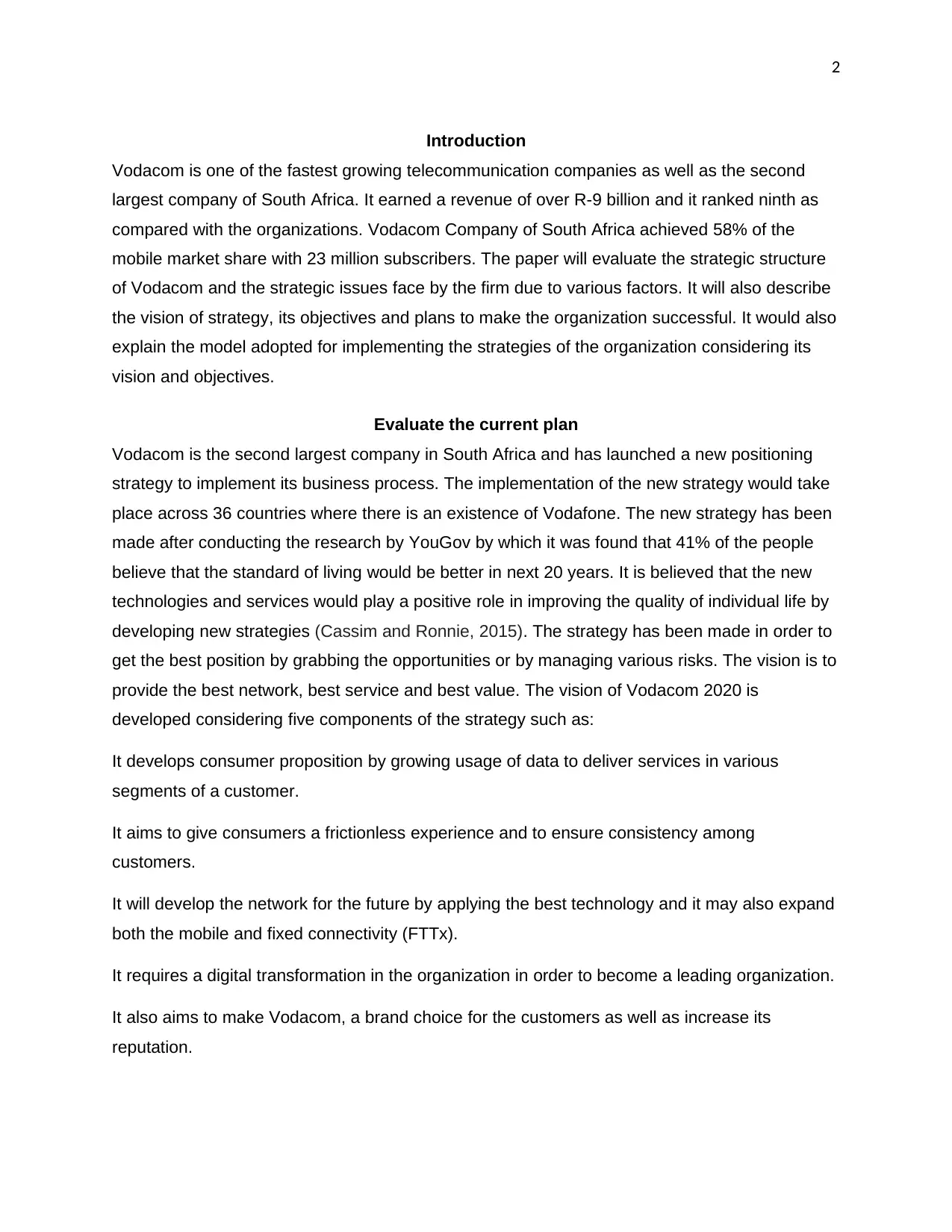
2
Introduction
Vodacom is one of the fastest growing telecommunication companies as well as the second
largest company of South Africa. It earned a revenue of over R-9 billion and it ranked ninth as
compared with the organizations. Vodacom Company of South Africa achieved 58% of the
mobile market share with 23 million subscribers. The paper will evaluate the strategic structure
of Vodacom and the strategic issues face by the firm due to various factors. It will also describe
the vision of strategy, its objectives and plans to make the organization successful. It would also
explain the model adopted for implementing the strategies of the organization considering its
vision and objectives.
Evaluate the current plan
Vodacom is the second largest company in South Africa and has launched a new positioning
strategy to implement its business process. The implementation of the new strategy would take
place across 36 countries where there is an existence of Vodafone. The new strategy has been
made after conducting the research by YouGov by which it was found that 41% of the people
believe that the standard of living would be better in next 20 years. It is believed that the new
technologies and services would play a positive role in improving the quality of individual life by
developing new strategies (Cassim and Ronnie, 2015). The strategy has been made in order to
get the best position by grabbing the opportunities or by managing various risks. The vision is to
provide the best network, best service and best value. The vision of Vodacom 2020 is
developed considering five components of the strategy such as:
It develops consumer proposition by growing usage of data to deliver services in various
segments of a customer.
It aims to give consumers a frictionless experience and to ensure consistency among
customers.
It will develop the network for the future by applying the best technology and it may also expand
both the mobile and fixed connectivity (FTTx).
It requires a digital transformation in the organization in order to become a leading organization.
It also aims to make Vodacom, a brand choice for the customers as well as increase its
reputation.
Introduction
Vodacom is one of the fastest growing telecommunication companies as well as the second
largest company of South Africa. It earned a revenue of over R-9 billion and it ranked ninth as
compared with the organizations. Vodacom Company of South Africa achieved 58% of the
mobile market share with 23 million subscribers. The paper will evaluate the strategic structure
of Vodacom and the strategic issues face by the firm due to various factors. It will also describe
the vision of strategy, its objectives and plans to make the organization successful. It would also
explain the model adopted for implementing the strategies of the organization considering its
vision and objectives.
Evaluate the current plan
Vodacom is the second largest company in South Africa and has launched a new positioning
strategy to implement its business process. The implementation of the new strategy would take
place across 36 countries where there is an existence of Vodafone. The new strategy has been
made after conducting the research by YouGov by which it was found that 41% of the people
believe that the standard of living would be better in next 20 years. It is believed that the new
technologies and services would play a positive role in improving the quality of individual life by
developing new strategies (Cassim and Ronnie, 2015). The strategy has been made in order to
get the best position by grabbing the opportunities or by managing various risks. The vision is to
provide the best network, best service and best value. The vision of Vodacom 2020 is
developed considering five components of the strategy such as:
It develops consumer proposition by growing usage of data to deliver services in various
segments of a customer.
It aims to give consumers a frictionless experience and to ensure consistency among
customers.
It will develop the network for the future by applying the best technology and it may also expand
both the mobile and fixed connectivity (FTTx).
It requires a digital transformation in the organization in order to become a leading organization.
It also aims to make Vodacom, a brand choice for the customers as well as increase its
reputation.
⊘ This is a preview!⊘
Do you want full access?
Subscribe today to unlock all pages.

Trusted by 1+ million students worldwide
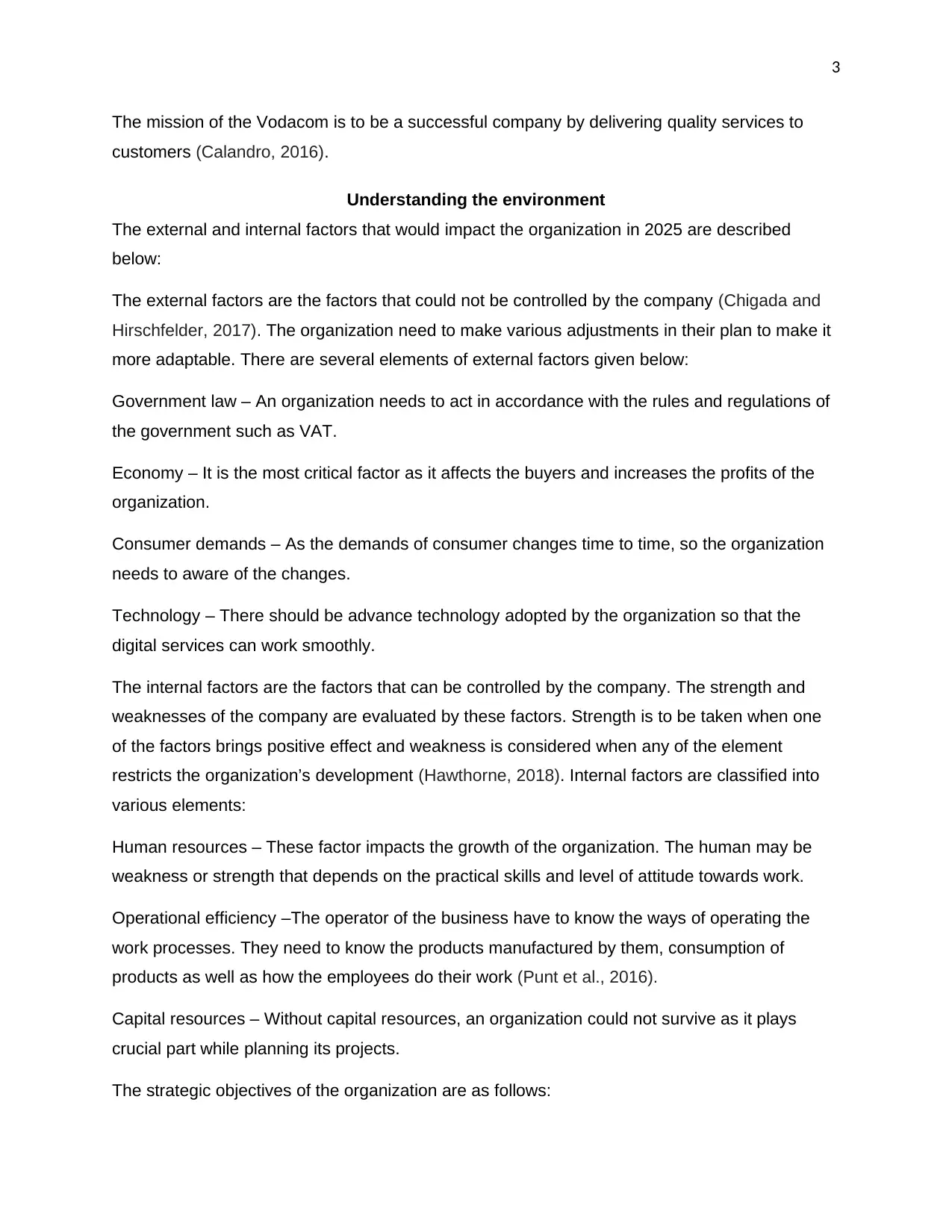
3
The mission of the Vodacom is to be a successful company by delivering quality services to
customers (Calandro, 2016).
Understanding the environment
The external and internal factors that would impact the organization in 2025 are described
below:
The external factors are the factors that could not be controlled by the company (Chigada and
Hirschfelder, 2017). The organization need to make various adjustments in their plan to make it
more adaptable. There are several elements of external factors given below:
Government law – An organization needs to act in accordance with the rules and regulations of
the government such as VAT.
Economy – It is the most critical factor as it affects the buyers and increases the profits of the
organization.
Consumer demands – As the demands of consumer changes time to time, so the organization
needs to aware of the changes.
Technology – There should be advance technology adopted by the organization so that the
digital services can work smoothly.
The internal factors are the factors that can be controlled by the company. The strength and
weaknesses of the company are evaluated by these factors. Strength is to be taken when one
of the factors brings positive effect and weakness is considered when any of the element
restricts the organization’s development (Hawthorne, 2018). Internal factors are classified into
various elements:
Human resources – These factor impacts the growth of the organization. The human may be
weakness or strength that depends on the practical skills and level of attitude towards work.
Operational efficiency –The operator of the business have to know the ways of operating the
work processes. They need to know the products manufactured by them, consumption of
products as well as how the employees do their work (Punt et al., 2016).
Capital resources – Without capital resources, an organization could not survive as it plays
crucial part while planning its projects.
The strategic objectives of the organization are as follows:
The mission of the Vodacom is to be a successful company by delivering quality services to
customers (Calandro, 2016).
Understanding the environment
The external and internal factors that would impact the organization in 2025 are described
below:
The external factors are the factors that could not be controlled by the company (Chigada and
Hirschfelder, 2017). The organization need to make various adjustments in their plan to make it
more adaptable. There are several elements of external factors given below:
Government law – An organization needs to act in accordance with the rules and regulations of
the government such as VAT.
Economy – It is the most critical factor as it affects the buyers and increases the profits of the
organization.
Consumer demands – As the demands of consumer changes time to time, so the organization
needs to aware of the changes.
Technology – There should be advance technology adopted by the organization so that the
digital services can work smoothly.
The internal factors are the factors that can be controlled by the company. The strength and
weaknesses of the company are evaluated by these factors. Strength is to be taken when one
of the factors brings positive effect and weakness is considered when any of the element
restricts the organization’s development (Hawthorne, 2018). Internal factors are classified into
various elements:
Human resources – These factor impacts the growth of the organization. The human may be
weakness or strength that depends on the practical skills and level of attitude towards work.
Operational efficiency –The operator of the business have to know the ways of operating the
work processes. They need to know the products manufactured by them, consumption of
products as well as how the employees do their work (Punt et al., 2016).
Capital resources – Without capital resources, an organization could not survive as it plays
crucial part while planning its projects.
The strategic objectives of the organization are as follows:
Paraphrase This Document
Need a fresh take? Get an instant paraphrase of this document with our AI Paraphraser
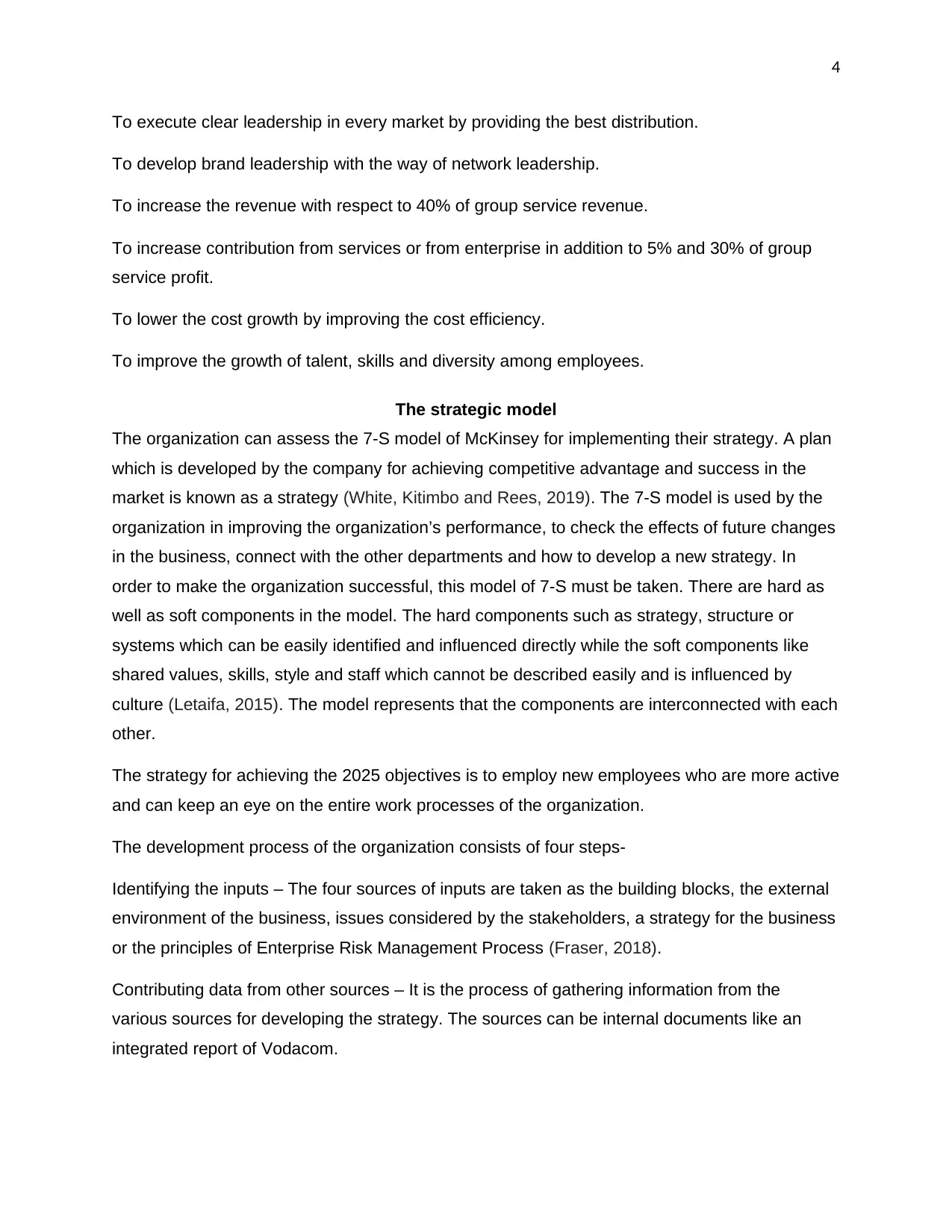
4
To execute clear leadership in every market by providing the best distribution.
To develop brand leadership with the way of network leadership.
To increase the revenue with respect to 40% of group service revenue.
To increase contribution from services or from enterprise in addition to 5% and 30% of group
service profit.
To lower the cost growth by improving the cost efficiency.
To improve the growth of talent, skills and diversity among employees.
The strategic model
The organization can assess the 7-S model of McKinsey for implementing their strategy. A plan
which is developed by the company for achieving competitive advantage and success in the
market is known as a strategy (White, Kitimbo and Rees, 2019). The 7-S model is used by the
organization in improving the organization’s performance, to check the effects of future changes
in the business, connect with the other departments and how to develop a new strategy. In
order to make the organization successful, this model of 7-S must be taken. There are hard as
well as soft components in the model. The hard components such as strategy, structure or
systems which can be easily identified and influenced directly while the soft components like
shared values, skills, style and staff which cannot be described easily and is influenced by
culture (Letaifa, 2015). The model represents that the components are interconnected with each
other.
The strategy for achieving the 2025 objectives is to employ new employees who are more active
and can keep an eye on the entire work processes of the organization.
The development process of the organization consists of four steps-
Identifying the inputs – The four sources of inputs are taken as the building blocks, the external
environment of the business, issues considered by the stakeholders, a strategy for the business
or the principles of Enterprise Risk Management Process (Fraser, 2018).
Contributing data from other sources – It is the process of gathering information from the
various sources for developing the strategy. The sources can be internal documents like an
integrated report of Vodacom.
To execute clear leadership in every market by providing the best distribution.
To develop brand leadership with the way of network leadership.
To increase the revenue with respect to 40% of group service revenue.
To increase contribution from services or from enterprise in addition to 5% and 30% of group
service profit.
To lower the cost growth by improving the cost efficiency.
To improve the growth of talent, skills and diversity among employees.
The strategic model
The organization can assess the 7-S model of McKinsey for implementing their strategy. A plan
which is developed by the company for achieving competitive advantage and success in the
market is known as a strategy (White, Kitimbo and Rees, 2019). The 7-S model is used by the
organization in improving the organization’s performance, to check the effects of future changes
in the business, connect with the other departments and how to develop a new strategy. In
order to make the organization successful, this model of 7-S must be taken. There are hard as
well as soft components in the model. The hard components such as strategy, structure or
systems which can be easily identified and influenced directly while the soft components like
shared values, skills, style and staff which cannot be described easily and is influenced by
culture (Letaifa, 2015). The model represents that the components are interconnected with each
other.
The strategy for achieving the 2025 objectives is to employ new employees who are more active
and can keep an eye on the entire work processes of the organization.
The development process of the organization consists of four steps-
Identifying the inputs – The four sources of inputs are taken as the building blocks, the external
environment of the business, issues considered by the stakeholders, a strategy for the business
or the principles of Enterprise Risk Management Process (Fraser, 2018).
Contributing data from other sources – It is the process of gathering information from the
various sources for developing the strategy. The sources can be internal documents like an
integrated report of Vodacom.
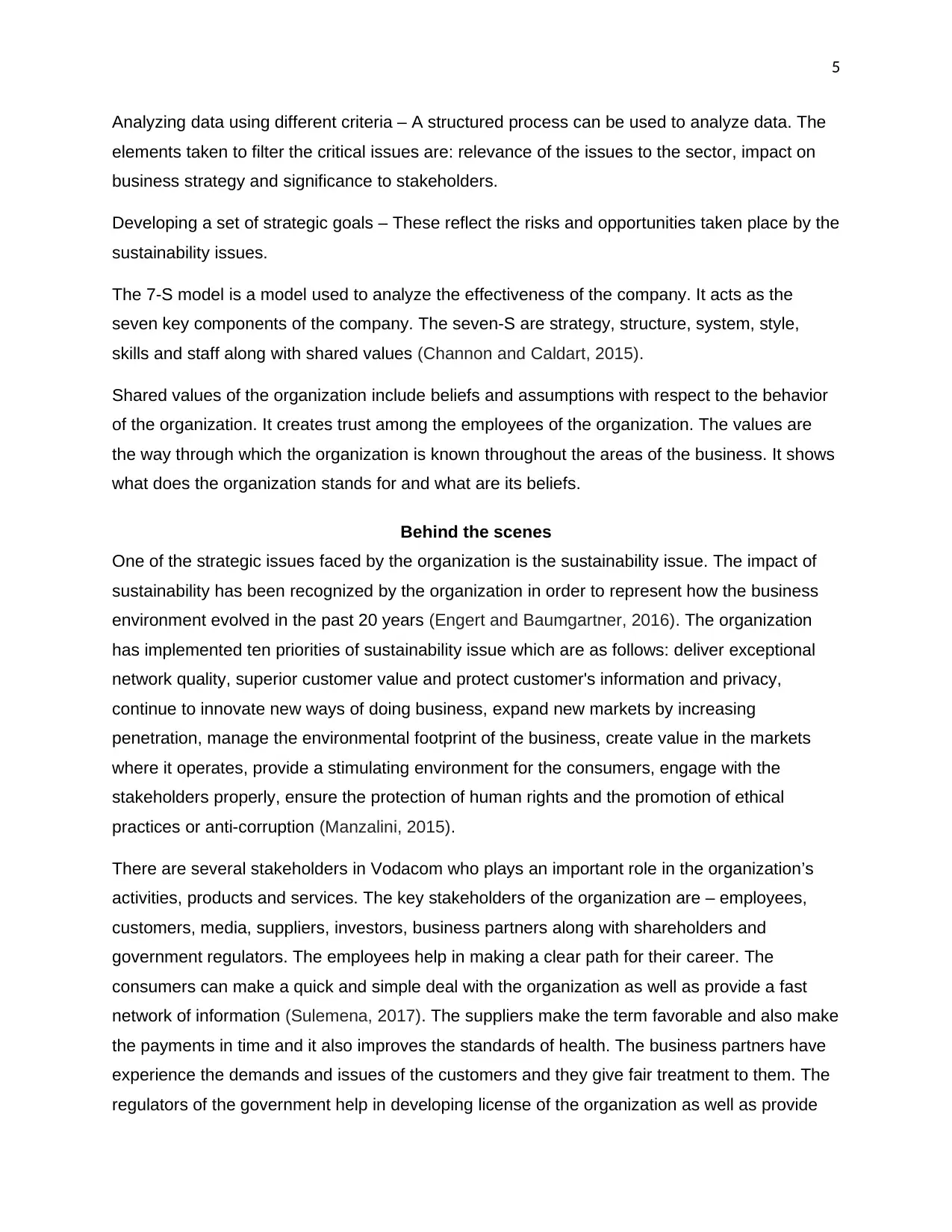
5
Analyzing data using different criteria – A structured process can be used to analyze data. The
elements taken to filter the critical issues are: relevance of the issues to the sector, impact on
business strategy and significance to stakeholders.
Developing a set of strategic goals – These reflect the risks and opportunities taken place by the
sustainability issues.
The 7-S model is a model used to analyze the effectiveness of the company. It acts as the
seven key components of the company. The seven-S are strategy, structure, system, style,
skills and staff along with shared values (Channon and Caldart, 2015).
Shared values of the organization include beliefs and assumptions with respect to the behavior
of the organization. It creates trust among the employees of the organization. The values are
the way through which the organization is known throughout the areas of the business. It shows
what does the organization stands for and what are its beliefs.
Behind the scenes
One of the strategic issues faced by the organization is the sustainability issue. The impact of
sustainability has been recognized by the organization in order to represent how the business
environment evolved in the past 20 years (Engert and Baumgartner, 2016). The organization
has implemented ten priorities of sustainability issue which are as follows: deliver exceptional
network quality, superior customer value and protect customer's information and privacy,
continue to innovate new ways of doing business, expand new markets by increasing
penetration, manage the environmental footprint of the business, create value in the markets
where it operates, provide a stimulating environment for the consumers, engage with the
stakeholders properly, ensure the protection of human rights and the promotion of ethical
practices or anti-corruption (Manzalini, 2015).
There are several stakeholders in Vodacom who plays an important role in the organization’s
activities, products and services. The key stakeholders of the organization are – employees,
customers, media, suppliers, investors, business partners along with shareholders and
government regulators. The employees help in making a clear path for their career. The
consumers can make a quick and simple deal with the organization as well as provide a fast
network of information (Sulemena, 2017). The suppliers make the term favorable and also make
the payments in time and it also improves the standards of health. The business partners have
experience the demands and issues of the customers and they give fair treatment to them. The
regulators of the government help in developing license of the organization as well as provide
Analyzing data using different criteria – A structured process can be used to analyze data. The
elements taken to filter the critical issues are: relevance of the issues to the sector, impact on
business strategy and significance to stakeholders.
Developing a set of strategic goals – These reflect the risks and opportunities taken place by the
sustainability issues.
The 7-S model is a model used to analyze the effectiveness of the company. It acts as the
seven key components of the company. The seven-S are strategy, structure, system, style,
skills and staff along with shared values (Channon and Caldart, 2015).
Shared values of the organization include beliefs and assumptions with respect to the behavior
of the organization. It creates trust among the employees of the organization. The values are
the way through which the organization is known throughout the areas of the business. It shows
what does the organization stands for and what are its beliefs.
Behind the scenes
One of the strategic issues faced by the organization is the sustainability issue. The impact of
sustainability has been recognized by the organization in order to represent how the business
environment evolved in the past 20 years (Engert and Baumgartner, 2016). The organization
has implemented ten priorities of sustainability issue which are as follows: deliver exceptional
network quality, superior customer value and protect customer's information and privacy,
continue to innovate new ways of doing business, expand new markets by increasing
penetration, manage the environmental footprint of the business, create value in the markets
where it operates, provide a stimulating environment for the consumers, engage with the
stakeholders properly, ensure the protection of human rights and the promotion of ethical
practices or anti-corruption (Manzalini, 2015).
There are several stakeholders in Vodacom who plays an important role in the organization’s
activities, products and services. The key stakeholders of the organization are – employees,
customers, media, suppliers, investors, business partners along with shareholders and
government regulators. The employees help in making a clear path for their career. The
consumers can make a quick and simple deal with the organization as well as provide a fast
network of information (Sulemena, 2017). The suppliers make the term favorable and also make
the payments in time and it also improves the standards of health. The business partners have
experience the demands and issues of the customers and they give fair treatment to them. The
regulators of the government help in developing license of the organization as well as provide
⊘ This is a preview!⊘
Do you want full access?
Subscribe today to unlock all pages.

Trusted by 1+ million students worldwide
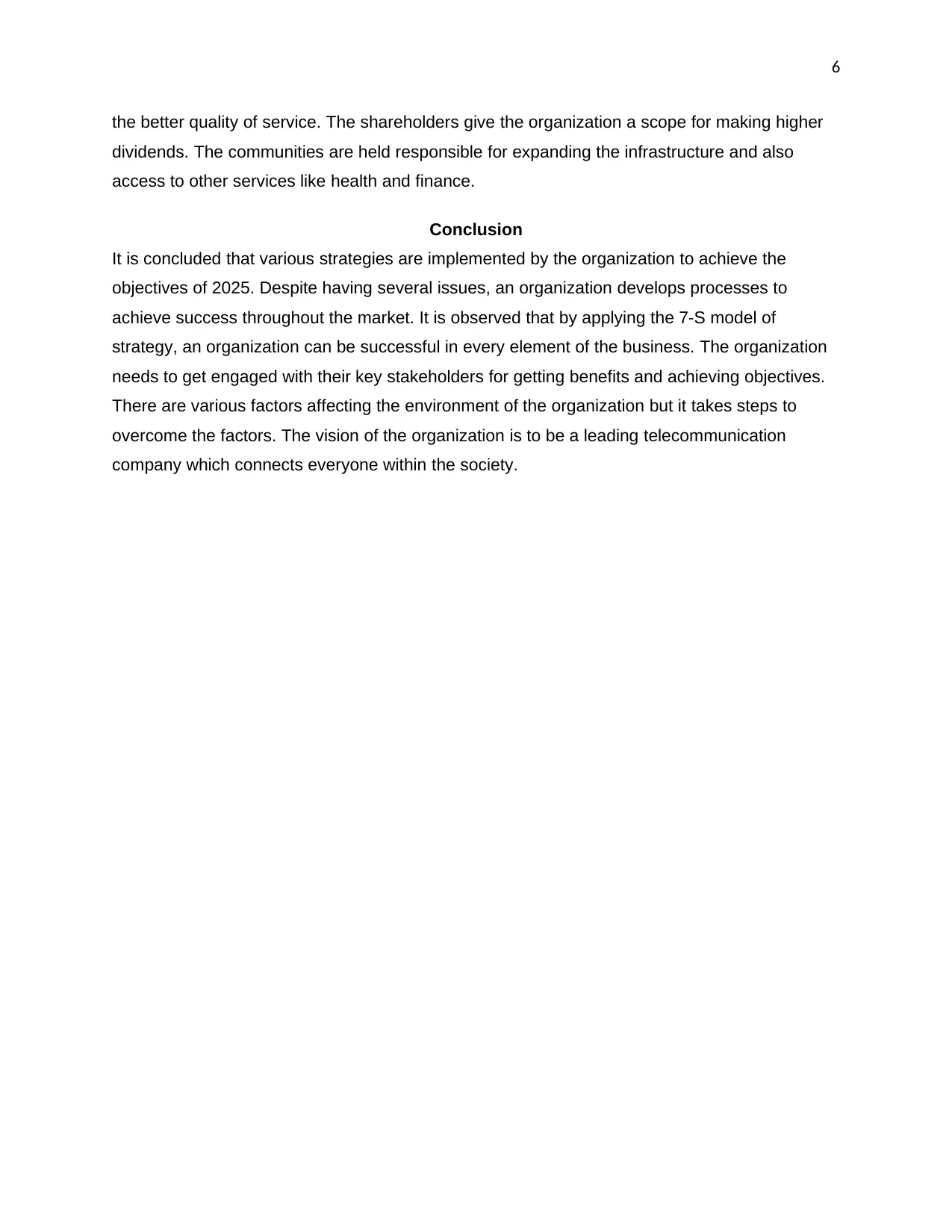
6
the better quality of service. The shareholders give the organization a scope for making higher
dividends. The communities are held responsible for expanding the infrastructure and also
access to other services like health and finance.
Conclusion
It is concluded that various strategies are implemented by the organization to achieve the
objectives of 2025. Despite having several issues, an organization develops processes to
achieve success throughout the market. It is observed that by applying the 7-S model of
strategy, an organization can be successful in every element of the business. The organization
needs to get engaged with their key stakeholders for getting benefits and achieving objectives.
There are various factors affecting the environment of the organization but it takes steps to
overcome the factors. The vision of the organization is to be a leading telecommunication
company which connects everyone within the society.
the better quality of service. The shareholders give the organization a scope for making higher
dividends. The communities are held responsible for expanding the infrastructure and also
access to other services like health and finance.
Conclusion
It is concluded that various strategies are implemented by the organization to achieve the
objectives of 2025. Despite having several issues, an organization develops processes to
achieve success throughout the market. It is observed that by applying the 7-S model of
strategy, an organization can be successful in every element of the business. The organization
needs to get engaged with their key stakeholders for getting benefits and achieving objectives.
There are various factors affecting the environment of the organization but it takes steps to
overcome the factors. The vision of the organization is to be a leading telecommunication
company which connects everyone within the society.
Paraphrase This Document
Need a fresh take? Get an instant paraphrase of this document with our AI Paraphraser
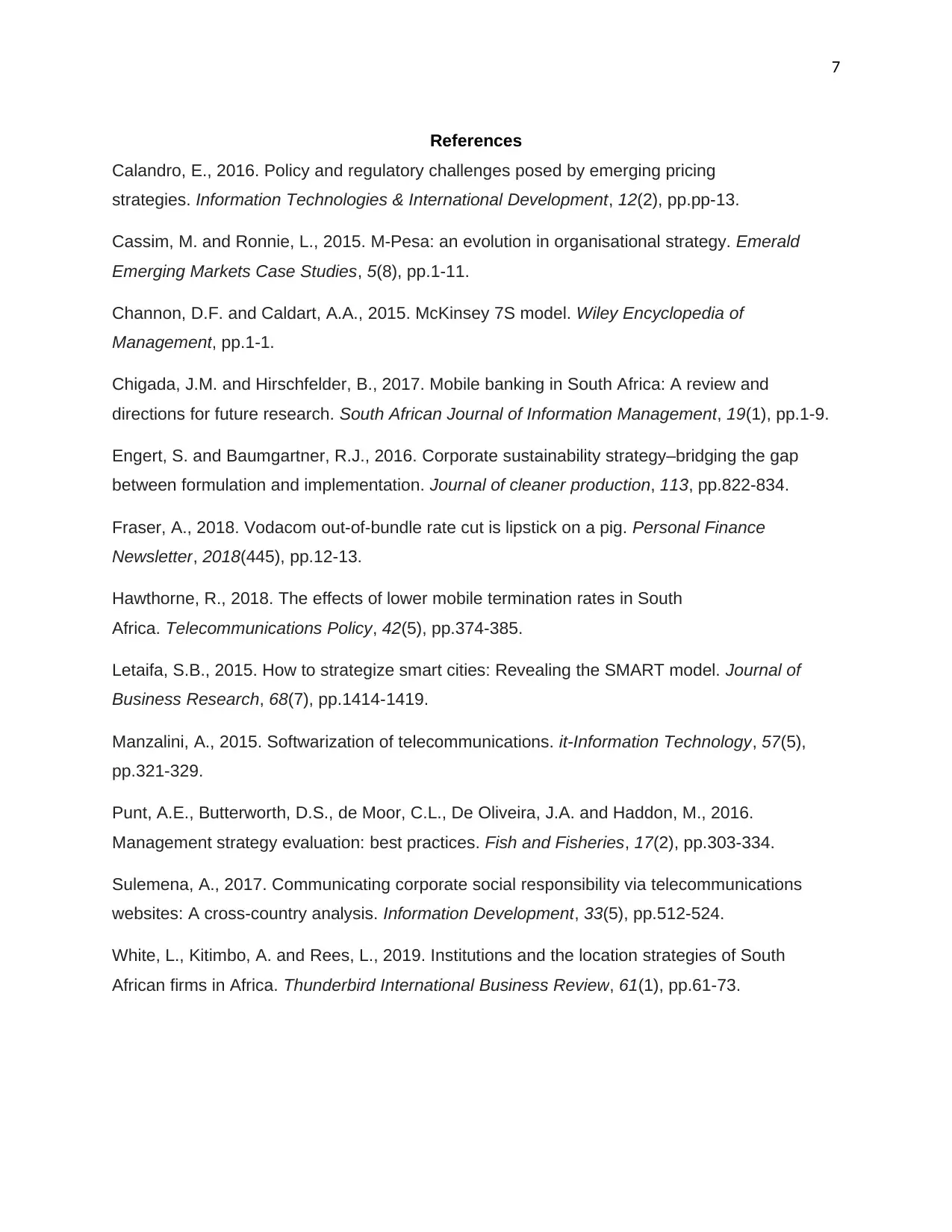
7
References
Calandro, E., 2016. Policy and regulatory challenges posed by emerging pricing
strategies. Information Technologies & International Development, 12(2), pp.pp-13.
Cassim, M. and Ronnie, L., 2015. M-Pesa: an evolution in organisational strategy. Emerald
Emerging Markets Case Studies, 5(8), pp.1-11.
Channon, D.F. and Caldart, A.A., 2015. McKinsey 7S model. Wiley Encyclopedia of
Management, pp.1-1.
Chigada, J.M. and Hirschfelder, B., 2017. Mobile banking in South Africa: A review and
directions for future research. South African Journal of Information Management, 19(1), pp.1-9.
Engert, S. and Baumgartner, R.J., 2016. Corporate sustainability strategy–bridging the gap
between formulation and implementation. Journal of cleaner production, 113, pp.822-834.
Fraser, A., 2018. Vodacom out-of-bundle rate cut is lipstick on a pig. Personal Finance
Newsletter, 2018(445), pp.12-13.
Hawthorne, R., 2018. The effects of lower mobile termination rates in South
Africa. Telecommunications Policy, 42(5), pp.374-385.
Letaifa, S.B., 2015. How to strategize smart cities: Revealing the SMART model. Journal of
Business Research, 68(7), pp.1414-1419.
Manzalini, A., 2015. Softwarization of telecommunications. it-Information Technology, 57(5),
pp.321-329.
Punt, A.E., Butterworth, D.S., de Moor, C.L., De Oliveira, J.A. and Haddon, M., 2016.
Management strategy evaluation: best practices. Fish and Fisheries, 17(2), pp.303-334.
Sulemena, A., 2017. Communicating corporate social responsibility via telecommunications
websites: A cross-country analysis. Information Development, 33(5), pp.512-524.
White, L., Kitimbo, A. and Rees, L., 2019. Institutions and the location strategies of South
African firms in Africa. Thunderbird International Business Review, 61(1), pp.61-73.
References
Calandro, E., 2016. Policy and regulatory challenges posed by emerging pricing
strategies. Information Technologies & International Development, 12(2), pp.pp-13.
Cassim, M. and Ronnie, L., 2015. M-Pesa: an evolution in organisational strategy. Emerald
Emerging Markets Case Studies, 5(8), pp.1-11.
Channon, D.F. and Caldart, A.A., 2015. McKinsey 7S model. Wiley Encyclopedia of
Management, pp.1-1.
Chigada, J.M. and Hirschfelder, B., 2017. Mobile banking in South Africa: A review and
directions for future research. South African Journal of Information Management, 19(1), pp.1-9.
Engert, S. and Baumgartner, R.J., 2016. Corporate sustainability strategy–bridging the gap
between formulation and implementation. Journal of cleaner production, 113, pp.822-834.
Fraser, A., 2018. Vodacom out-of-bundle rate cut is lipstick on a pig. Personal Finance
Newsletter, 2018(445), pp.12-13.
Hawthorne, R., 2018. The effects of lower mobile termination rates in South
Africa. Telecommunications Policy, 42(5), pp.374-385.
Letaifa, S.B., 2015. How to strategize smart cities: Revealing the SMART model. Journal of
Business Research, 68(7), pp.1414-1419.
Manzalini, A., 2015. Softwarization of telecommunications. it-Information Technology, 57(5),
pp.321-329.
Punt, A.E., Butterworth, D.S., de Moor, C.L., De Oliveira, J.A. and Haddon, M., 2016.
Management strategy evaluation: best practices. Fish and Fisheries, 17(2), pp.303-334.
Sulemena, A., 2017. Communicating corporate social responsibility via telecommunications
websites: A cross-country analysis. Information Development, 33(5), pp.512-524.
White, L., Kitimbo, A. and Rees, L., 2019. Institutions and the location strategies of South
African firms in Africa. Thunderbird International Business Review, 61(1), pp.61-73.
1 out of 8
Related Documents
Your All-in-One AI-Powered Toolkit for Academic Success.
+13062052269
info@desklib.com
Available 24*7 on WhatsApp / Email
![[object Object]](/_next/static/media/star-bottom.7253800d.svg)
Unlock your academic potential
Copyright © 2020–2025 A2Z Services. All Rights Reserved. Developed and managed by ZUCOL.




